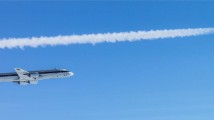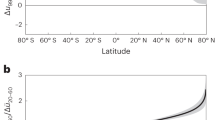Abstract
Air traffic condensation trails, or contrails, are believed to have a net atmospheric warming effect1, although one that is currently small compared to that induced by other sources of human emissions. However, the comparably large growth rate of air traffic requires an improved understanding of the resulting impact of aircraft radiative forcing on climate2. Contrails have an effect on the Earth's energy balance similar to that of high thin ice clouds3. Their trapping of outgoing longwave radiation emitted by the Earth and atmosphere (positive radiative forcing) is partly compensated by their reflection of incoming solar radiation (negative radiative forcing). On average, the longwave effect dominates and the net contrail radiative forcing is believed to be positive1,2,4. Over daily and annual timescales, varying levels of air traffic, meteorological conditions, and solar insolation influence the net forcing effect of contrails. Here we determine the factors most important for contrail climate forcing using a sophisticated radiative transfer model5,6 for a site in southeast England, located in the entrance to the North Atlantic flight corridor. We find that night-time flights during winter (December to February) are responsible for most of the contrail radiative forcing. Night flights account for only 25 per cent of daily air traffic, but contribute 60 to 80 per cent of the contrail forcing. Further, winter flights account for only 22 per cent of annual air traffic, but contribute half of the annual mean forcing. These results suggest that flight rescheduling could help to minimize the climate impact of aviation.
This is a preview of subscription content, access via your institution
Access options
Subscribe to this journal
Receive 51 print issues and online access
$199.00 per year
only $3.90 per issue
Buy this article
- Purchase on Springer Link
- Instant access to full article PDF
Prices may be subject to local taxes which are calculated during checkout



Similar content being viewed by others
References
The IPCC Working Group Aviation and the Global Atmosphere—A Special Report of IPCC Working Groups I and III (eds Penner, J. E. et al.) (Cambridge Univ. Press, Cambridge, UK, 1999)
Sausen, R. et al. Aviation radiative forcing in 2000: An update on the IPCC (1999). Meteorol. Z. 14, 555–561 (2005)
Hartmann, D. L., Ockert-Bell, M. E. & Michelsen, M. L. The effect of cloud type on Earth's energy balance: global analysis. J. Clim. 5, 1281–1304 (1992)
Minnis, P., Schumann, U., Doelling, D. R., Gierens, K. M. & Fahey, D. W. Global distribution of contrail radiative forcing. Geophys. Res. Lett. 26, 1853–1856 (1999)
Fu, Q. & Liou, K. N. On the correlated k-distribution method for radiative transfer in nonhomogeneous atmospheres. J. Atmos. Sci. 49, 2139–2156 (1992)
Fu, Q. & Liou, K. N. Parameterization of the radiative properties of cirrus clouds. J. Atmos. Sci. 50, 2008–2025 (1993)
Schumann, U. On conditions for contrail formation from aircraft exhausts. Meteorol. Z. 5, 4–23 (1996)
Gierens, K., Schumann, U., Helten, M., Smit, H. G. J. & Marenco, A. A distribution law for relative humidity in the upper troposphere and lower stratosphere derived from three years of MOZAIC measurements. Ann. Geophys. 17, 1218–1226 (1999)
Sausen, R., Nodorp, D., Land, C. & Deidewig, F. Ermittlung optimaler Flughöhen und Flugrouten unter dem Aspekt minimaler Klimawirksamkeit 96–13 (DLR-Forschungsbericht, Cologne, Germany, 1996)
Williams, V. & Noland, R. B. Variability of contrail formation conditions and the implications for policies to reduce the climate impacts of aviation. Transp. Res. Part D 10, 269–280 (2005)
Myhre, G. & Stordal, F. On the tradeoff of the solar and thermal infrared radiative impact of contrails. Geophys. Res. Lett. 28, 3119–3122 (2001)
Eyers, C. J. et al. AERO2k Global Aviation Emissions Inventories for 2002 and 2025 (QinetiQ Ltd, Farnborough, UK, 2004)
Schumann, U. On the effect of emissions from aircraft engines on the state of the atmosphere. Ann. Geophys. 12, 365–384 (1994)
Gierens, K. M. Numerical simulations of persistent contrails. J. Atmos. Sci. 53, 3333–3348 (1996)
Wang, J., Cole, H. L., Carlson, D. J., Miller, E. R. & Beierle, K. Corrections of humidity measurement errors from the Vaisala RS80 radiosonde—Application to TOGA COARE Data. J. Atmos. Oceanic Technol. 19, 981–1002 (2002)
Schmidt, E. Die Entstehung von Eisnebel aus den Auspuffgasen von Flugmotoren. Schr. deutsch. Akad. Luftfahrtforsch. 44, 1–15 (1941)
Appleman, H. The formation of exhaust condensation trails by jet aircraft. Bull. Am. Meteorol. Soc. 34, 14–20 (1953)
Kley, D. et al. (eds) SPARC Assessment of Upper Tropospheric and Stratospheric Water Vapour WCRP-113, WMO/TD-No. 1043 (SPARC, Verrières le Buisson Cedex, 2000)
Strauss, B., Meerkötter, R., Wissinger, B., Wendling, P. & Hess, M. On the regional climatic impact of contrails: microphysical and radiative properties of contrails and natural cirrus clouds. Ann. Geophys. 15, 1457–1467 (1997)
Jensen, E. J. et al. Environmental conditions required for contrail formation and persistence. J. Geophys. Res. 103 (D4), 3929–3936 (1998)
Schumann, U. Influence of propulsion efficiency on contrail formation. Aerosp. Sci. Technol. 4, 391–401 (2000)
Bakan, S., Betancor, M., Gayler, V. & Grassl, H. Contrail frequency over Europe from NOAA-satellite images. Ann. Geophys. 12, 962–968 (1994)
Mannstein, H., Meyer, R. & Wendling, P. Operational detection of contrails from NOAA-AVHRR-data. Int. J. Remote Sens. 20, 1641–1660 (1999)
Detwiler, A. & Pratt, R. Clear-air seeding: opportunities and strategies. J. Weath. Modif. 16, 46–60 (1984)
Gierens, K. & Spichtinger, P. On the size distribution of ice-supersaturated regions in the upper troposphere and lowermost stratosphere. Ann. Geophys. 18, 499–504 (2000)
Stephenson, D. B. Use of the “odds ratio” for diagnosing forecast skill. Weath. Forecast. 15, 221–232 (2000)
Meyer, B., Mannstein, H., Meerkötter, R., Schumann, U. & Wendling, P. Regional radiative forcing by line-shaped contrails derived from satellite data. J. Geophys. Res. 107 (D10), 4104, doi: 10.1029/2001JD000426 (2002)
Ponater, M., Marquart, S. & Sausen, R. Contrails in a comprehensive climate model: Parameterization and radiative forcing results. J. Geophys. Res. 107 (D13), 4164, doi: 10.1029/2001JD000429 (2002)
Marquart, S., Ponater, M. & Sausen, R. Future development of contrail cover, optical depth, and radiative forcing: Impacts of increasing air traffic and climate change. J. Clim. 16, 2890–2904 (2003)
Rossow, W. B., Garder, L., Lu, P.-J. & Walker, A. International Satellite Cloud Climatology Project (ISCCP) Documentation of Cloud Data WMO/TD 266 (World Climate Research Programme, Geneva, 1988)
Acknowledgements
We thank Q. Fu for providing the basic radiative transfer code and C. Eyers for the AERO2k data. Radiosonde data was provided by the British Atmospheric Data Centre (BADC). A. Tompkins (ECMWF) provided us with analysis data. N.S. was supported by the Department for Transport, and G.R. by the Department of Trade and Industry, and Airbus. Author Contributions N.S. was the principal researcher. G.R. performed analysis of contrail observations. P.F. led the research with significant contributions from K.S.
Author information
Authors and Affiliations
Corresponding author
Ethics declarations
Competing interests
Reprints and permissions information is available at npg.nature.com/reprintsandpermissions. The authors declare no competing financial interests.
Rights and permissions
About this article
Cite this article
Stuber, N., Forster, P., Rädel, G. et al. The importance of the diurnal and annual cycle of air traffic for contrail radiative forcing. Nature 441, 864–867 (2006). https://doi.org/10.1038/nature04877
Received:
Accepted:
Issue Date:
DOI: https://doi.org/10.1038/nature04877
This article is cited by
-
Record high solar irradiance in Western Europe during first COVID-19 lockdown largely due to unusual weather
Communications Earth & Environment (2021)
-
A number-based inventory of size-resolved black carbon particle emissions by global civil aviation
Nature Communications (2019)
-
Impacts of climate warming on maximum aviation payloads
Climate Dynamics (2019)
-
Formation and radiative forcing of contrail cirrus
Nature Communications (2018)
-
Decreased takeoff performance of aircraft due to climate change
Climatic Change (2018)
Comments
By submitting a comment you agree to abide by our Terms and Community Guidelines. If you find something abusive or that does not comply with our terms or guidelines please flag it as inappropriate.



